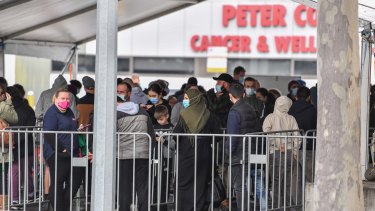Victoria records 50 new local COVID-19 cases as close contact exposure sites swell
Victoria has recorded 50 new local coronavirus cases as close contact exposure sites crop up across the state, dimming any prospect of restrictions being eased on schedule early next month.
Of the new cases, 40 have been linked to current outbreaks. Health authorities are investigating the acquisition source for the remaining 10 cases.

Authorities identified more than a dozen new close contact exposure sites in Shepparton on Monday. Credit:Joe Armao
Eleven of Tuesday’s new COVID-19 cases, recorded from more than 48,420 tests, were in isolation for their entire infectious period.
In the past seven days, almost 80 Victorians have been infected without knowing how they picked up the virus, up from 17 the previous week.
Some of these cases were linked after further investigation, but epidemiologists believe the quantity of cases not immediately able to be connected is a sign of an uncontrolled outbreak.
An Andrews government source, speaking anonymously so as to make predictions, said it was highly probable the state’s lockdown would extend beyond September 2 because of both the number of mystery cases and the number of cases not in isolation rising.
More than 29,800 people received their COVID-19 vaccine doses in Victoria in the past 24 hours. The state recorded one case of coronavirus in hotel quarantine.
Close contact exposure sites swellThe figures come after health authorities identified another 18 new close contact or tier-1 exposure sites late on Monday evening, including a Woolworths in Altona North.
Tier 1 means anyone who attended the sites during the specified timeframes has to immediately get tested for COVID-19 and quarantine for 14 days, regardless of whether they receive a negative result.
Victoria’s COVID-19 response commander Jeroen Weimar on Monday pleaded with young men in the Altona North and Newport communities to come forward and get tested for coronavirus.
Sirius College’s secondary boys’ campus Meadow Fair at Broadmeadows was also identified as a close contact exposure site late on Monday evening, as was Notre Dame College in Shepparton.
Mr Weimar flagged on Monday that the school was among those caught up in the regional city’s COVID-19 outbreak, which has grown to 36 active cases.
Goulburn Valley Health chief executive Matt Sharp said a positive case linked to the college meant several thousand people connected with the school would need to be tested, blowing out initial estimates of 10,000 to 11,000 tests being required in the community.
He said the school had about 1600 students and 300 staff.
“If you add that up with household contacts of all of those people and their families, we’re looking at several thousand people who are also going to need testing,†he said.
A number of other venues in Shepparton were also declared close contact exposure sites on Monday evening, including a hairdresser, an ALDI, a Woolworths, and a cafe.
Reopening still safe with hundreds of daily COVID cases: Doherty Institute bossThe director of the Doherty Institute, whose modelling underlies the national plan to reopen Australia, said reopening with large numbers of daily COVID-19 cases will still be safe once the country reaches its target of 70 to 80 per cent of the adult population vaccinated.
Professor Sharon Lewin confirmed the number of cases did not materially alter the Institute’s modelling on which the plan was based.
“The really big important issue about moving from phase A to phase B is that we’re moving out of an environment of zero-COVID,†she told the ABC’s The Drum program on Monday evening. “Zero-COVID is no longer the goal once you have 70 to 80 per cent of people vaccinated. Whether you start at 30 cases or 800 cases you can still open up safely.â€
Travel restrictions downgraded for Northern Territory, QueenslandVictoria’s Chief Health Officer has downgraded the travel zoning of local government areas in Northern Territory and Queensland.
The changes came into effect at 11.59pm on Monday, with Cairns and Yarrabah in Queensland now considered “green zones†under Victoria’s travel permit system.
That means there are no restrictions on those entering the state from those localities, however, travellers will still need to obtain a travel permit.
Northern Territory “red zones†in the Greater Darwin and Katherine local government areas were also downgraded to become “orange zones†from midnight on Monday.
People who now enter Victoria from those two areas of the Northern Territory will be required to isolate, get tested within 72 hours and stay isolated until they receive a negative result.
With Michael Koziol, Ashleigh McMillian, Benjamin Preiss and Rachel Eddie
Cassandra Morgan is a breaking news reporter at The Age.
Paul Sakkal is a Victorian political reporter for The Age.
Melissa Cunningham is The Age's health reporter.
0 Response to "Victoria records 50 new local COVID-19 cases as close contact exposure sites swell"
Post a Comment